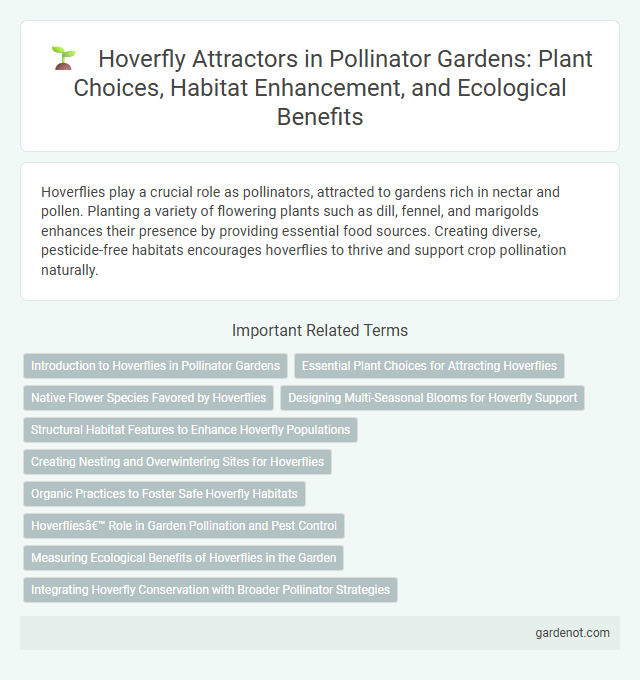Hoverflies play a crucial role as pollinators, attracted to gardens rich in nectar and pollen. Planting a variety of flowering plants such as dill, fennel, and marigolds enhances their presence by providing essential food sources. Creating diverse, pesticide-free habitats encourages hoverflies to thrive and support crop pollination naturally.
Introduction to Hoverflies in Pollinator Gardens
Hoverflies, also known as syrphid flies, play a crucial role in pollinator gardens by efficiently transferring pollen while mimicking bees and wasps, which deters predators. Their larvae consume aphids and other pests, contributing to natural pest control and supporting plant health. Incorporating hoverfly-attracting plants, such as alyssum, fennel, and yarrow, enhances biodiversity and promotes a balanced garden ecosystem.
Essential Plant Choices for Attracting Hoverflies
Essential plant choices for attracting hoverflies include flowers rich in nectar and pollen such as alyssum, yarrow, and dill, which provide vital food sources for adults. Umbelliferous plants like fennel, coriander, and Queen Anne's lace create ideal landing platforms and nectar access. Incorporating a diverse range of bloom times ensures a continuous supply of nutrients, supporting hoverfly populations throughout the growing season.
Native Flower Species Favored by Hoverflies
Native flower species such as yarrow (Achillea millefolium), dill (Anethum graveolens), and wild carrot (Daucus carota) are particularly favored by hoverflies for their nectar and pollen resources. These plants provide essential habitat and food sources that support hoverfly populations, which are crucial pollinators in pollinator gardens. Incorporating these native species enhances biodiversity and promotes natural pest control through hoverfly larvae feeding on aphids.
Designing Multi-Seasonal Blooms for Hoverfly Support
Designing multi-seasonal blooms for hoverfly support involves selecting a diverse range of native flowering plants that provide nectar and pollen from early spring to late fall. Incorporating umbrella-shaped flowers such as fennel, dill, and yarrow encourages hoverfly visitation by facilitating easy access to food sources. Ensuring continuous floral availability enhances hoverfly populations, which play a crucial role in pollination and natural pest control within the garden ecosystem.
Structural Habitat Features to Enhance Hoverfly Populations
Structural habitat features such as dense flowering plants, vertical layers of vegetation, and diverse plant species significantly enhance hoverfly populations by providing essential nectar sources and breeding sites. Incorporating sheltered areas like tall grasses and hollow stems supports hoverfly larvae development and adult resting spots. These habitat complexities increase pollination efficiency and biodiversity within pollinator gardens.
Creating Nesting and Overwintering Sites for Hoverflies
Creating nesting and overwintering sites for hoverflies involves providing undisturbed areas with hollow stems, leaf litter, and decaying wood to support their life cycle. Incorporating native flowering plants such as dill, fennel, and coriander encourages hoverfly attraction by offering both nectar and shelter. Maintaining these habitats enhances pollination efficiency and contributes to biodiversity in pollinator gardens.
Organic Practices to Foster Safe Hoverfly Habitats
Organic practices such as planting native flowering plants and avoiding synthetic pesticides create safe habitats that attract hoverflies, essential pollinators in garden ecosystems. Incorporating diverse nectar and pollen sources supports hoverfly larvae development and adult foraging, enhancing pollination and natural pest control. Maintaining mulch layers and providing shallow water sources further encourage hoverfly presence and biodiversity in pollinator gardens.
Hoverflies’ Role in Garden Pollination and Pest Control
Hoverflies play a crucial role in garden pollination by efficiently transferring pollen between flowers, enhancing fruit and vegetable yields. Their larvae act as natural pest controllers by consuming aphids and other harmful insects, reducing the need for chemical pesticides. Incorporating plants like fennel, dill, and alyssum in a pollinator garden attracts hoverflies, supporting ecosystem health and biodiversity.
Measuring Ecological Benefits of Hoverflies in the Garden
Hoverflies significantly enhance garden pollination by transferring pollen efficiently between flowers, contributing to increased fruit and seed production. Quantitative studies reveal hoverfly visitation rates correlate with a 30-50% boost in pollination success, supporting biodiversity and ecosystem stability. Monitoring hoverfly species diversity and abundance using standardized protocols provides critical data for assessing their ecological impact in pollinator gardens.
Integrating Hoverfly Conservation with Broader Pollinator Strategies
Integrating hoverfly conservation with broader pollinator strategies enhances ecosystem resilience and promotes effective pollination services in garden habitats. Hoverflies, key pollinators of various flowering plants, complement bees by extending pollination periods and targeting different floral species. Incorporating hoverfly attractors such as flowering herbs, Apiaceae plants, and providing larval habitats contributes to diversified pollinator networks essential for sustainable garden pollination.
Hoverfly attractor Infographic

 gardenot.com
gardenot.com